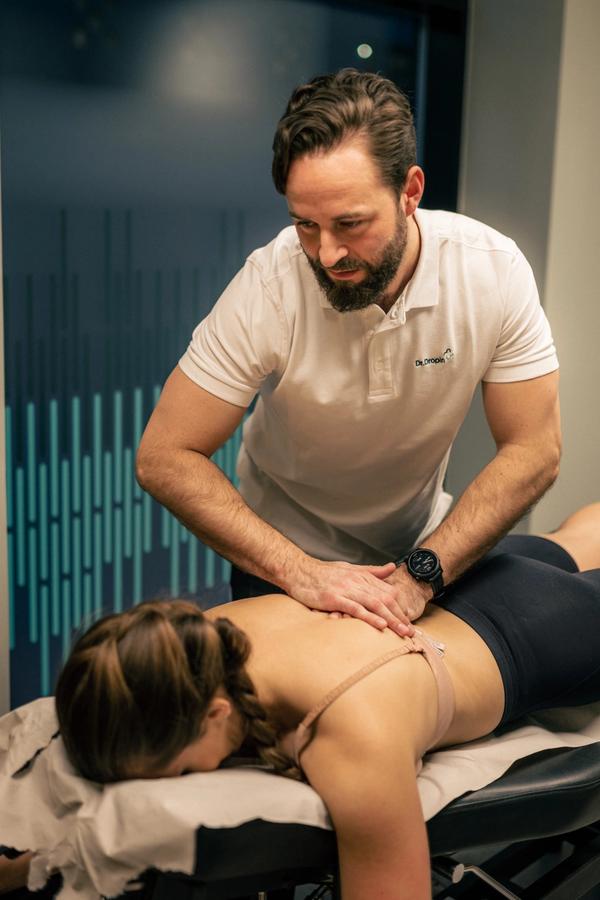BBPV
Benign Paroxysmal Positional Vertigo (BPPV), commonly known as vertigo, affects approximately 80,000 Norwegians annually. This condition impacts the inner ear's balance organ, causing dizziness and a sensation of the room spinning. Loose crystals within the balance organ disrupt its normal function. While usually not dangerous, vertigo can be highly distressing. In cases of acute dizziness, it's crucial to consult a doctor to rule out other causes, especially if other symptoms like fever, double vision, or speech difficulties occur.
At Dr.Dropin, our experienced practitioners can diagnose and treat vertigo to provide relief.
See availability
What are you looking for?
Symptoms of BBPV
If you have vertigo, you may experience one or more of the following symptoms:
- Intense episodes of dizziness, often triggered by changes in head position
- A feeling that your surroundings are spinning or rotating
- Nausea or vomiting associated with dizziness Nystagmus, which are involuntary, jerky eye movements
- Short-lived episodes of dizziness, typically lasting under one minute
Vertigo can be an uncomfortable condition, but it's generally not dangerous. Seeking professional guidance for an accurate diagnosis and treatment is essential when experiencing these symptoms.
See availability
Examination
Examination of vertigo involves specific head maneuvers to provoke brief dizziness while simultaneously observing nystagmus (involuntary eye movements). This helps pinpoint the problem's location within the balance organ. Tests are also conducted to rule out other causes of dizziness, such as strokes or viral infections of the vestibular nerve.
Treatment of BBPV
Most cases of benign paroxysmal positional vertigo (BPPV), commonly known as positional vertigo, improve naturally within about 3 weeks, but treatment can provide quicker relief. Treatment for BPPV typically involves specific head movements, such as the Epley maneuver, aimed at repositioning loose crystals within the balance organ's central area. Successful maneuvers result in immediate symptom relief, and some individuals may require multiple sessions. Patients can also learn to perform these maneuvers at home with guidance.
When should you book an appointment?
If you experience acute dizziness, it's best to consult a doctor initially. However, once more severe causes of dizziness have been ruled out, and you have received a diagnosis of benign paroxysmal positional vertigo (BPPV) or positional vertigo, it is advisable to contact a therapist who can assist you with treatment and help you return to your normal daily life.
See availability
Meet our therapists
Our physical team consists of skilled and committed therapists. We have solid expertise, clinical experience and Norwegian authorization, so you can trust that you get the help you need. You do not need a referral to book an appointment with us.
We know that the right competence and good chemistry are important. Below you can therefore get to know our therapists better.


Daniel Vestøl
Chiropractor, Bislett
General Chiropractic | Headache | Acute and prolonged dizziness | Prolonged pain

Lovisa Klingenberg
Chiropractor, Økern
General Chiropractic | Acute and prolonged dizziness | Prolonged pain | Diagnostic ultrasound

Wictor Borgström
Physiotherapist, Sandvika
General Physiotherapy | Rehabilitation | Acute and prolonged dizziness

Hildegunn Lilja Solsvik
Physiotherapist, Majorstuen
General physiotherapy | Psychomotor physiotherapy | Acute and long-term dizziness | Vestibular disorders | Tinnitus | Meniere's disease

Heidi Prytz
Chiropractor
General Chiropractic | Back | Neck | Women's Health | Needle treatment | Headache

Ana-Maria Stefan
Chiropractor, Majorstuen
General Chiropractic | Headache | Women's Health | Pregnancy | Prolonged pain

Ingrid-Johanne Nilsen
Chiropractor, Bergen city center
General Chiropractic | Headache | Women's health | Pregnancy

Lina Beate Varhaug
Chiropractor, Stavanger sentrum
General Chiropractic | Back | Neck | Women's Health | Pregnancy | Shock wave therapy | Headache | Dizziness

Nikolai Nyenget
Chiropractor, Trondheim city center
General Chiropractic | Sports injuries | Shock wave treatment | Foot analysis and sole fitting | Plantar fasciitis | Headache
Do you want guidance to find out which treatment suits you best?

Telephone
Authorized healthcare personnel assist you over the phone. We answer the phone within 60 seconds. Free of charge.

Find therapist
Find a therapist that suits you and your needs by filtering on one or more criteria.
Use your health insurance
We cooperate with all the major insurance companies, so that you can use your health insurance with us if you have elbow pain or other problems.
Read more about how to use your health insurance here
What can you do by yourself?
Seek medical attention at the first episode of dizziness. If you have been diagnosed with benign paroxysmal positional vertigo (BPPV), it is possible to perform the repositioning maneuvers at home, but it can be challenging due to the intensity of dizziness. The dizziness itself is harmless but can be very uncomfortable.
Frequently asked questions about BBPV
What are the symptoms of benign paroxysmal positional vertigo (BPPV)?
Typical symptoms of BPPV include severe episodes of dizziness, a feeling that the surroundings are spinning or rotating (vertigo), nausea or vomiting associated with dizziness, nystagmus (involuntary, jerky eye movements), and brief dizziness episodes usually lasting less than one minute.
What are the symptoms of benign paroxysmal positional vertigo (BPPV)?
Typical symptoms of BPPV include severe episodes of dizziness, a feeling that the surroundings are spinning or rotating (vertigo), nausea or vomiting associated with dizziness, nystagmus (involuntary, jerky eye movements), and brief dizziness episodes usually lasting less than one minute.
What triggers benign paroxysmal positional vertigo (BPPV)?
BPPV is often triggered by sudden changes in head position, such as when turning in bed, getting up quickly, or bending forward. These movements can disturb the loose crystals in the balance organ and lead to symptoms.
What triggers benign paroxysmal positional vertigo (BPPV)?
BPPV is often triggered by sudden changes in head position, such as when turning in bed, getting up quickly, or bending forward. These movements can disturb the loose crystals in the balance organ and lead to symptoms.
How long does benign paroxysmal positional vertigo (BPPV) typically last?
Most people experience an improvement in BPPV symptoms within about 3 weeks, but with proper treatment, the symptoms can resolve much earlier.
How long does benign paroxysmal positional vertigo (BPPV) typically last?
Most people experience an improvement in BPPV symptoms within about 3 weeks, but with proper treatment, the symptoms can resolve much earlier.
What should you do if you have benign paroxysmal positional vertigo (BPPV)?
If you experience your first episode of dizziness, it's advisable to consult a doctor to rule out other causes of dizziness. If you receive a diagnosis of BPPV, you can seek help from a therapist who can guide you through repositioning maneuvers to alleviate the symptoms. These maneuvers can also be performed at home under guidance.
What should you do if you have benign paroxysmal positional vertigo (BPPV)?
If you experience your first episode of dizziness, it's advisable to consult a doctor to rule out other causes of dizziness. If you receive a diagnosis of BPPV, you can seek help from a therapist who can guide you through repositioning maneuvers to alleviate the symptoms. These maneuvers can also be performed at home under guidance.